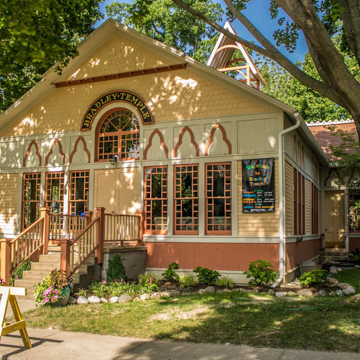Lakeside was established on the shores of Lake Erie as a Methodist camp meeting site in the summer of 1873. It soon developed into a permanent resort community and adopted the principles of the Chautauqua movement, offering a blend of religious and secular educational, cultural, and recreational programming. The Chautauqua movement began in the 1870s at Lake Chautauqua in New York and expanded throughout the late nineteenth century with the establishment of new communities, mostly in summer resorts as seasonal retreats to enrich the mind, body, and spirit. Lakeside is situated near the tip of the Marblehead Peninsula, just west of the village of Marblehead. It now consists of a one-square-mile site with a rectilinear grid of tree-lined streets and approximately 900 cottages and 47 commercial and community buildings, the most of which were built between 1875 and 1930. The grounds also include numerous outdoor recreational amenities like tennis, shuffleboard and volleyball courts, miniature golf, swimming and boating docks, and related structures. A private nonprofit organization, Lakeside Chautauqua, oversees and controls the entire community and continues to offer traditional programming each summer season. Private individuals own the cottages, leasing the land on which the cottages sit from Lakeside Chautauqua.
Lakeside expanded quickly in its early years, especially after the first section of Hotel Lakeside was completed in 1875 and a 3,000-seat, open-air auditorium opened in 1876. Chautauqua-related offerings began in 1877, just three years after that movement’s founding, and the growing Lakeside community enthusiastically embraced its principles during the last two decades of the nineteenth century. During that same period, Chautauqua itself expanded from an effort originally focused on training Sunday school teachers into a broader and more popular program of adult education and enrichment.
Although Lakeside was originally accessible only over land or by ferry, the 1887 construction of the Lakeside and Marblehead Railroad Depot provided passenger rail service directly to the site. Simple tents were steadily replaced by small wood-frame cottages, with as many as 400 completed by 1886, most of them similar to the cottages found at other camp meetings of the period. Lakeside’s eclectic Victorian-era cottages are similar in scale and character: they are predominately narrow, 2-story, front-gabled dwellings with prominent porches and balconies. Stylistically, however, they vary greatly in their Italianate, Gothic Revival, Second Empire, and Queen Anne decorative details.
Lakeside continued to grow through the first decades of the twentieth century, adding numerous Colonial Revival and Craftsman-influenced cottages along with a series of Mission Style community buildings. These include the 1921 Lakeside Administration Building, 1928 Orchestra Hall, and 1929 Hoover Auditorium. A small commercial district also developed near the north end of the property at the intersection of Second and Walnut streets. The community continued to evolve in the succeeding decades, as existing cottages were enlarged and modified and new cottages were added. A new hotel was constructed in 1962. Lakeside’s waterfront pavilion has been reconstructed multiple times, most recently in the late 1980s, in an effort to reinstate its original nineteenth-century appearance. Buildings from the second half of the twentieth century are relatively few and are scattered throughout the community. As a result, Lakeside still closely resembles its overall appearance before 1930. Few individual designers or builders are identified with Lakeside’s buildings; most of the cottages reflect house types and architectural styles typical of the late nineteenth and early twentieth centuries, especially as they were distributed through pattern books, plan books, and local building traditions. Several of the major public buildings are attributed to specific architects and architectural firms.
Lakeside continues to attract tens of thousands of visitors each summer and boasts an increasing number of year-round residents. The entire community is an historic district listed on the National Register.
References
Hare, A. J, and Sinz and Fausel Lith. Lakeside summer resort and camp ground, near Sandusky, Ohio. Sandusky, A. J. Hare, 1884. Map. Geography and Map Division, Library of Congress.
Kestle, James Allen. This is Lakeside, 1873-1973. Lakeside, OH: Lakeside Heritage Society, 1973.
Ligibel, Ted J., “Lakeside,” Ottawa County, Ohio. National Register of Historic Places Inventory–Nomination Form, 1983. National Park Service, U.S. Department of the Interior, Washington, D.C.
Shepard, O.L. The Story of Lakeside. Lakeside, OH: Lakeside Association, 1923.























